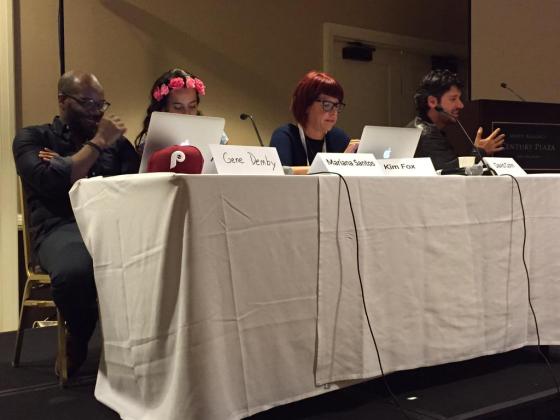If you’ve noticed sluggish download speeds for that iOS update while on the conference floor at ONA 15, it’s because C3-Wireless, the company providing Internet during the conference, makes sure the necessary applications — like Twitter — get WiFi priority.
The popular social media app is seen as a productivity-killer for other conferences, so it commonly gets pushed to the back of the Internet line. Not here, where a group of 2,000 wireless-hungry journalists are constantly chattering about panels, sessions and events.
“It’s not quite the number of people as much as the type of person that’s using it,” said Casey Collins, CEO of C3-Wireless.
To make sure the Internet doesn’t get bogged down, things like software updates, the iTunes store and Dropbox are de-prioritized. Twitter, Facebook and streaming, on the other hand, are guaranteed 10 percent of the network at any given time.
As of Saturday afternoon, ONA attendees had chomped through 696 gigabytes of data. Collins anticipates 800-900 will be consumed by the end of the conference. From 9 a.m. to 3 p.m., the mobile network averages about 100 megabits per second. “That’s crazy, to maintain that all day,” Collins said.
These numbers don’t reflect the “production” internet usage, which feeds stuff like ONA live streams and the Student Newsroom. It’s solely the mobile users in attendance — all 2,000 of them.
But it’s not just 2,000 attendees, it’s 2,000 small businesses. That’s how Irving Washington, deputy director for ONA, has to describe the annual event to WiFi providers when he’s setting things up before the conference. Journalists require more Internet access than other conferences with a comparable number of attendees, so some special provisions have to be made.
“It’s not a huge convention,” Washington said. “It’s pretty much mid-sized, but our members are unique in that they are very active on WiFi. We push the limits all the time.”
The Internet speed dipped during Thursday’s session to what Washington called a “slow crawl.” But he’s been happy with the overall performance in the days since that first hurdle.
Collins’s team at C3-Wireless initially allowed devices to choose between a 2.4-gigabyte band and a 5-gigabyte band. But too many devices defaulted to the smaller band, and that led to a lot of clutter. Once Collins made the switch to a larger band, the problem took care of itself.
That was a welcome relief for Washington, who has learned to accept slow Internet days during conferences.
“Some years we have a meltdown,” he said. “We had a slow crawl Thursday, but we haven’t had that meltdown yet.”
Attendees could get back to work filing stories, checking email and, of course, tweeting at normal speeds. There are 71 access points set up throughout conference areas to make sure the WiFi works smoothly.
The Hyatt’s WiFi provides about 100 megabits of bandwidth, while the ONA WiFi is currently set up for 500. Without those additional points, Collins said, the Internet wouldn’t even function for this event.








You must be logged in to post a comment.